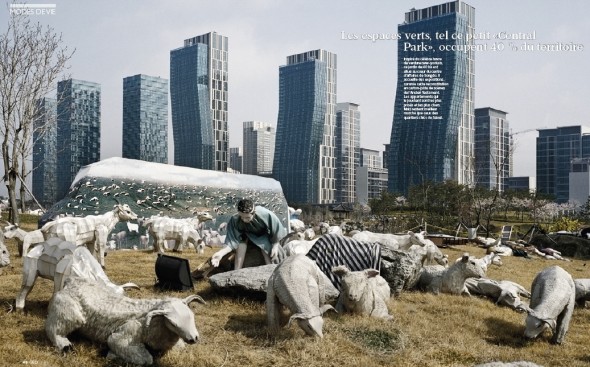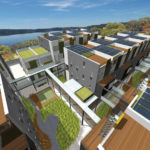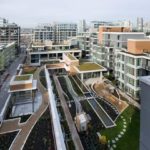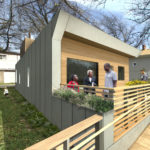We must re-create cities greener and more sustainable from the ground up. The goal: compact living environments requiring less resources that maximize utilization of land, water and energy. Here are some suggestions.
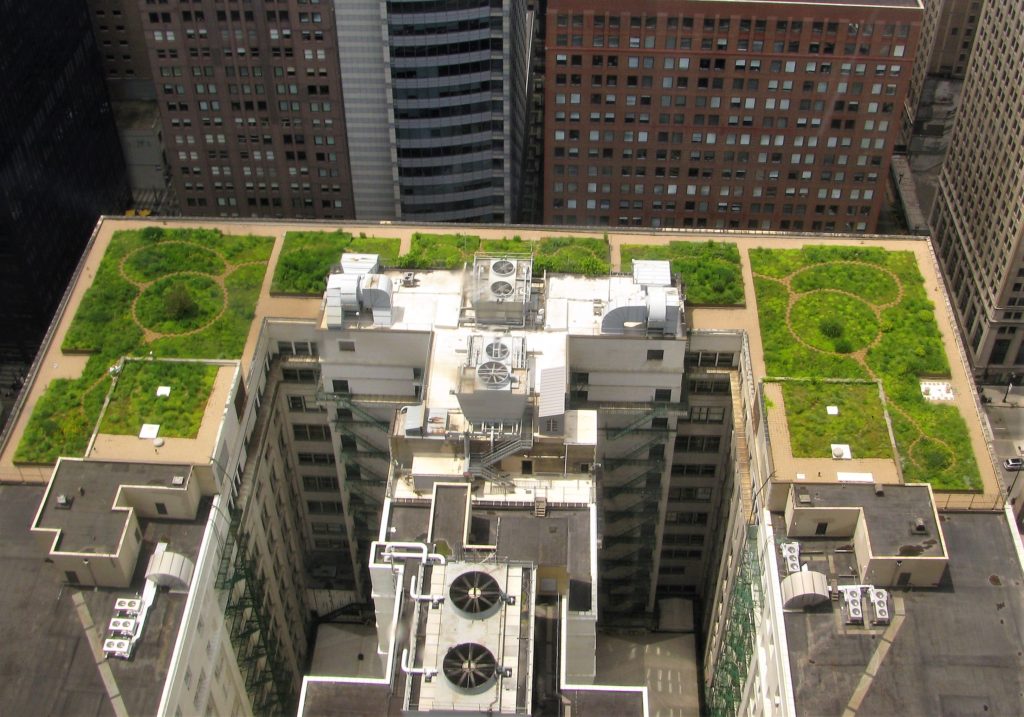

Eco-Cities: An Environmental Solution to Sustainability?
Adapted from the Article Published in The Wall Street Journal By Michael Totty
In the next 20 years, world urban populations could soar to five billion from more than three billion today. Assuming the current rate of urbanization, cities will account for nearly three-quarters of the world’s energy demand by 2030. Most of the increase will come in rapidly developing countries like China and India; China’s cities alone will have to deliver water, housing, transportation and other services to 400 million additional urban dwellers by 2030.
So, we must rethink cities greener from the ground up. The goal: compact living environments requiring less resources that maximize utilization of land, water and energy. “There’s going to have to be new forms of energy, new ways of delivering energy and new forms of infrastructure,” says Warren Karlenzig, president of Common Current, a consulting firm on sustainable cities based in San Anselmo, Calif. “All this will be necessary to allow cities to operate the way they do now.”
Not long ago the idea of using “green” and “city” in the same sentence seemed absurd. Cities were considered a blight on the environment: energy-hogging, pollution-spewing, garbage-producing environmental hellholes.
Yet in recent years, some areas have developed as models of green virtue. City dwellers tend to walk more and drive less than their suburban counterparts, and dense urban development encourages transit use. Apartment living generally means lower per-household energy use.
Building on these strengths, planners and developers are devising innovative solutions to meet urbanites’ energy, water, transportation and sanitation needs well into the future. Some improvements are easy, such as switching to energy-efficient LED lighting in buildings and streetlights, or setting aside bike lanes and widening sidewalks to encourage alternatives to driving (although such moves aren’t without political hazards, as a recent battle over bike lanes in New York shows). Others are more ambitious, requiring new construction or even an extensive rebuilding of city infrastructure—consider what is needed to add a second set of pipes for a water-reuse system.
Some of the most ambitious projects—and the greatest source of innovative ideas—are the dozens of “eco-city” developments in the works or on drawing boards around the world. Projects like the Songdo International Business District near Incheon, South Korea, are testing grounds for the latest in green technologies.
STORY: Songdo, South Korea: Utopian City of Big Data and Urban “Sustainability”
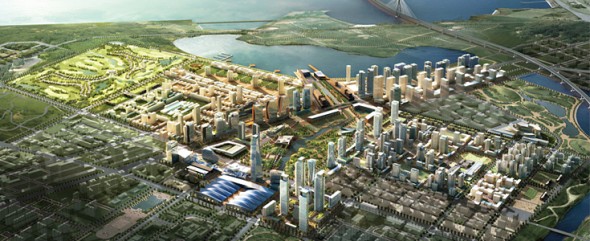

But green initiatives aren’t just found on blueprints for new cities. Chicago, for example, has about 350 green-roof projects covering more than 4.5 million square feet.
Of course, many of these initiatives can be expensive, with high up-front costs. Urban planners say savings from lower energy bills and other operational efficiencies can more than cover the added expenses, but the break-even point can be years out. Still, cities—unlike the average homeowner considering rooftop solar panels—can take a long view and make investments with a decades-long payback.
District Heating
In a typical office building, heating and cooling account for nearly two-thirds of total energy use. So an alternative to traditional electricity or natural gas HVAC systems can go a long way toward making cities greener. One solution: tapping the excess heat produced by nearby utilities or industry. A network of pipes distributes the heat, which can be used for hot water, space heating and in absorbption chillers to provide air conditioning in the summer. These district heating systems are considerably more efficinet — capturing up to 90 percent of the available energy — than in-building boilers. And they can tap any number of heat sources, including high-efficiency natural gas turbines, large-scale solar thermal systems, biomass incinerators ofr furnaces in a steel mill. Common in Europe, high-efficiency district heating systems are being used in South Korea’s Songdo IBD and are in plans for other eco-city developments.

Micro Wind Turbines
The giant windmills that dot the countryside aren’t suitable for cities, where vibrations can rattle windows and the noise would be annoying. So developers are turning to microturbines. These small generators sit atop commercial or residential buildings and are designed to take advantage of the quirks of big-city wind patterns — lots of turbulence and frequent, sudden shifts in direction. The turbines are generally small, rated at one to three kilowatts each. But when installed in arrays and combined with high-efficiency solar panels, they can generate a large share of a building’s energy needs, especially when the structure is equipped with a full-set of energy-saving features. A handful of companies provide micro-wind systems around the world, and the devices, while more expensive per kilowatt than larger systems, have been installed at scores of locations, including PepsiCo Inc’s Chicago office building.
Pumped Hydro Storage/Micro Hydropower
Wind and solar power are notoriously fickle, producing more power than needed at some times and less than needed at others. A city that wants to rely on such intermittent sources needs to find a way to bank that power. One technique: pumped hydroelectric storage. When wind or solar power are plentiful, electricity is used to pump water to an upper reservoir; later, when power is needed, the water is allowed to flow downhill, turning turbines in the process. The lakes have added benefit as open space landscaping. Large-scale pumped-hydro are increasingly used for storing energy, and many isolated towns rely on small-scale micro hydro plants to generate electricity. Adding a pumped-storage capability isn’t technically difficult, but it’s expensive, especially on a small-scale, and current technology generally requires a large “drop” or change in elevation to produce much power — though companies are working on lower-floe hydro turbines that can work in more level settings.
As well, projects that utilize wilderness habitat or preserved open space as potential storage reservoirs are to be avoided much like a project in Lake Elsinore, California a few years ago which sought to create a reservoir high in the Cleveland National Forest for a “drop,” which was abandoned for its obvious environmental impacts and marginal benefit.
Walking and Biking
When it comes to transportation, dense urban areas like Manhattan already have an advantage over suburbs: By packing people, jobs and services close together, they reduce the need for many car trips and provide the density to support bus and transit services. Green-city planners do even more, designing streets with dedicated walking right-of-way with landscaping and crosswalks, as well as providing separate designated bicycle lanes. Songdo’s 1,500 acres are designed so most shops, parks and transit stops can be reached in less than a 15-minute walk, and the city also has a 15-mile network of bike lanes.
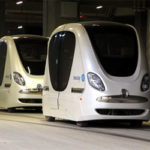

Personal Rapid Transit
Cities can encourage greener auto choices by providing electric vehicle charging stations in parking garages. A futuristic solution: personal rapid transit, or PRT — pod-like, self-powered vehicles that can carry as many as six passengers. The vehicles can travel along dedicated roadways, like an automated airport transit system, or on streets equipped with buried magnets. There are no fixed schedules or routes; passengers pick their destinations, and a central computer guides the car without intermediate stops. Although still a novelty, PRTs are operating at Heathrow International Airport near London and at the Masdar Institute of Science and Technology in Masdar City, an eco-city development in Abu Dhabi. Masdar, however, has put on hold plans to deploy the pod cars throughout the entire planned two-square-mile development.
Waste to Resources
Getting to zero waste is as important to cities as getting to zero carbon. This doesn’t mean just encouraging residents to recycle — cities can also deploy technologies to tap the energy and other valuable resources buried in the trash. Advanced anaerobic digesters process organic garbage waste and the sludge left over from treating wastewater to produce biogas, which can be burned for energy; more common in Europe, the technology is just being deployed in the US for handling municipal garbage.
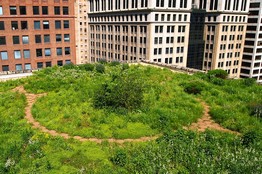

Green Roofs
Rooftops, which take up a fifth of urban surface area, can be used to support solar panes or wind turbines, but they’re otherwise underutuilized. Covering the tops of buildings with grasses, shrubs and other plants can deliver a host of benefits. Though often more costly that traditional coverings, green roofs can provide insulation and trim a building’s heating and cooling needs. They absorb rainwater, reducing the load on storm-water systems, and filter what water does run off so it can be used for many domestic needs. They also filter air pollutants.
Mr. Totty is a news editor for the Journal Report in San Francisco. He can be reached at michael.totty@wsj.com.
Update 9 June 2019

